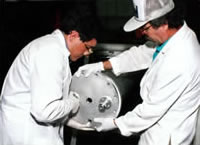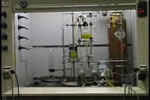
![]()
 |
| Single unit photoreactor, Ali Raissi and Nazim Murdov (Photo: Steven Spencer) |
|---|
FSEC's research in pollution control has focused on two areas – photocatalytic destruction of airborne pollutants and photolytic decomposition of hydrogen sulfide.
Airborne Pollutants
Using technologies based on photocatalytic production of hydrogen, FSEC researchers developed processes for the photocatalytic destruction of airborne pollutants. This work began when FSEC researchers showed that ultraviolet light and semiconductors in a photocatalytic process could completely mineralize pollutants to the oxides of their constitute elements, thus purifying air contaminated with hazardous chemicals. The resulting pollution control process use a FSEC patent which immobilizes a semiconductor catalyst on any surface and required specialized chemical engineering reactor designs.
In conducting this $2 million, seven-year research project, FSEC researchers conceived, tested and produced a state-of-the-art photocatalytic air pollution control technology that resulted in thirteen patents for its unique photoreactor design concepts.
The U.S. Navy, Army and Department of Defense have used the patented process to deal with toxic air pollutants (volatile organic compounds) emitted during various defense operations. The process was first applied in a Navy project located at the U.S. Naval Surface Warfare Center (NSWC), in Indian Head, MD. Following bench-scale tests at FSEC, staff constructed a bench-scale prototype air-purification system and delivered it to the NSWC for testing. FSEC then fabricated and tested a larger-scale system that treated 50 standard cubic feet per minute (SCFM) of contaminated air. These tests resulted in design parameters for a full-scale photocatalytic air-purification system installed and operated by the Navy at NSWC.
Trojan Technologies built the full-scale, 650 standard cubic foot per minute (SCFM) photoreactor according to FSEC's design. The unit employed a unique design and titanium-based photocatalytic cartridges activated by ultraviolet (UV) radiation from low-pressure mercury lamps. This photo-process featured a decoupled, single-pass flow feature, making it cost-effective and energy-efficient, while allowing it to operate at low temperatures. The full-scale unit was completed in 1999 and delivered to the Indian Head facility, where it underwent testing.
Decomposition of Hydrogen Sulfide
Another unique pollution control technology developed at FSEC is the photolytic decomposition of hydrogen sulfide. Research on health, environment, and air quality has long recognized that release of sulfur compounds from refineries and utility flue stacks must be reduced or eliminated.
Crude oil contains sulfur, typically on the order of 4% by weight, in the form of thiols, thiophenes, and other sulfur-containing organic compounds. In addition, sour gas clean-up at natural gas wells also contains sulfur. The sulfur must be removed before the oil or natural gas can be distributed throughout the petrochemical industry. By hydrotreating at the refinery, the sulfur is converted into the gaseous state as hydrogen sulfide (H2S), a noxious and toxic gas. Environmental regulations require that the by-product H2S be dealt with onsite. Considerable effort must then be directed toward treatment of this by-product. Current technology typically involves a solvent absorption/stripping process to separate the acid gases and a Claus reactor to perform a partial oxidation of the sulfide to make sulfur and water. Finally, a tertiary treatment is applied to produce another hundred-fold reduction in H2S concentration.
As part of FSEC's work on photocatlytic processes, researchers developed a UV-photochemical method for decomposing H2S into its constituent elements, hydrogen and sulfur. Two useful products are thus obtained: sulfur, that can be sold as a commodity (primarily to the fertilizer industry), and hydrogen gas, that can be likewise sold, used for clean process heat, or recycled back to the hydrosulfurization plant for reuse. This is in contrast to existing sulfur recovery technologies where the hydrogen and its energy content are lost, requiring refineries to continuously resupply themselves with process hydrogen. The work developing this process was funded by Gulf Coast Hazardous Substance Research Center and the Environmental Protection Agency and four patents have been issued.
 |
UV Photolytic Decomposition of Hydrogen Sulfide
to it's Constituent Elements |
Clovis Linkous - Running time: 8 minutes |
|
A second technology development involved the tail gases from electric utility plants and a tail gas sulfur recovery process. In this research and resulting control process, the hydrogen sulfide is absorbed into an alkaline solution and then decomposed using a solar photochemical reaction to yield both sulfur and hydrogen. The process uses catalyst-modified semiconductor particulates to facilitate the reaction. The project was also funded by Gulf Coast Hazardous Substance Research Center and the Environmental Protection Agency.
